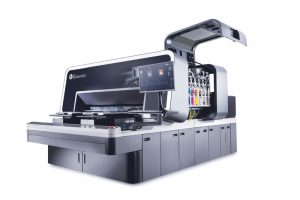
Sustainable, on-demand production provides an opportunity for reshoring operations
By Jecka Glasman
A recent Bloomberg article, “American Factories Are Making Stuff Again as CEOs Take Production Out of China,” observes the trend of bringing major manufacturing operations back to the United States, briefly seen as a stopgap measure to mitigate complications arising from the pandemic economy. This now appears to be part of a broader strategy for long-term operational viability, resiliency and value.
Per the article, “… the construction of new manufacturing facilities in the U.S. has soared 116 percent over the past year,” while a survey suggests many U.S.-based corporate executives see fit to move production out of China, with many such operations expected to return to the United States or Mexico. While high labor costs have long been used to justify offshore production, volatile supply chains, shipping complications and costs, tariffs, perceived sociopolitical instability, and other factors — including the proliferation of automation technologies that necessitate fewer laborers to operate in general — have made reshoring to North America a practical, profitable, and safer proposition.
While this development may come as news to some, here in the fashion and textile worlds this trend has been witnessed up close and personal. Indeed, the economics of bringing production closer to the end consumer — immediately delivery that negates the need for vast and vulnerable supply chains, the ability to react to demand in real time, the eco-friendly aspect of a streamlined process, and the mitigation of troublesome external factors in general — underlies the KornitX Global Fulfillment Network, which effectively nearshores production for every market.

(Photo: Haydon Perrior)
Localized Operations Using On Demand Technologies
Many of Kornit’s partners and customers are founding or adapting their businesses on the basis of localizing their operations, even in highly regulated and high-cost regions that would not, on their face, appear to be logical production sites. Yet, efficient, on-demand production technologies make these models highly profitable.
Consider Charlotte, N.C.-based Printful, a successful practitioner of on-demand digital direct-to-garment (DTG) fulfillment this past decade, which has thrived by localizing its operations across many regions, including several locations within the United States — including high-cost Los Angeles.
Also consider FABRIC, a so-called “fashion incubator” based in Tempe, Ariz., created to empower independent fashion designers to bring their creations to life, without significant up-front investment or commitment. Using Kornit’s sustainable, versatile, on-demand direct-to-fabric production capabilities, it is working to make Arizona a hotbed of fashion production.
Consider countless small businesses like Little Cocalico, Reinholds, Pa., where proprietor Jon Boll invested in Kornit’s sustainable, on-demand Kornit Presto S direct-to-fabric system because “people are realizing it’s not more expensive, and you can get better quality giving fellow Americans jobs and bringing production back to the United States, and bring sustainability and quality to their businesses.”

Modular Strategy
One of the greatest attributes of localized, on-demand fashion and textile production models is that the strategy is entirely modular; it can be replicated to mitigate risk, foster operational agility and versatility, and deliver profitability anywhere. Perhaps no Kornit partner exemplifies this proposition better than London-based Fashion-Enter, which employs both Kornit DTG and direct-to-fabric production systems to educate, empower, and fulfill the needs of aspiring fashion designers in the United Kingdom. That it can successfully do so within the city of London, the high-cost cradle of the Industrial Revolution itself, demonstrates how “Make It British” can also mean “make it sustainably, make it with superior quality, make it in any quantity, make it without limitations, make it brilliant — and make it cost-effectively every time.”
Regardless of the challenges we face, game-changing technologies have provided a solution in times of need. In the past 40 years, technological advancements have made considerable gains in areas of alleviating poverty, improving healthcare and wellness, revolutionizing the ways we communicate and shop, increasing our quality of life, and far more. Where simple economics once drove manufacturers to solve problems by simply moving operations to far-flung locations where both labor and space were cheap and plentiful, those committed to developing sustainable, efficient, highly automated, and versatile production technologies have made it more profitable than ever to bring those operations back home. What’s more, unpredictable global market dynamics, like any number of risks and complications we’ve seen these past few years, have compelled business leaders to embrace the wisdom of doing so.
In the Bloomberg piece, GE Appliances CEO Kevin Nolan summed up the situation succinctly: “I’ve always said, this is just economics, people are going to realize that the savings they thought they had (from offshoring operations) aren’t real, and it’s going to be better and cheaper to make them here.”
Editor’s Note: Jecka Glasman is chief commercial officer at Kornit Digital.
September/October 2022




